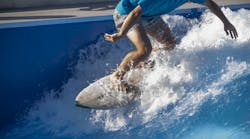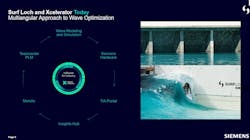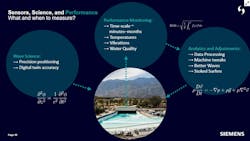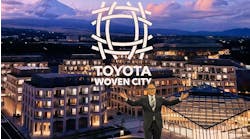Surf’s up! Wave-pool designers detail how they use digital twin and control systems tech to simulate the sea
Some manufacturers make necessary but mundane everyday things—baby bottles, broomsticks and suntan lotion—while others, like SoCal’s Surf Loch, do something that is totally rad. All need control software and hardware like those provided by Siemens to deliver the goods to their customers.
At a Smart Industry webinar on Oct. 4 sponsored by Advanced Technology Services, Seeq and GE Digital, Thomas Lochtefeld, CEO, founder and owner of Surf Loch and Wave Loch, and surf systems engineer Miles Miller detailed how the San Diego-based company does something “awesome, totally awesome,” as 80s surfer dude from the movies Jeff Spicoli famously said. Smart Industry Editor-in-Chief Robert Schoenberger moderated the chat with the pair from Surf Loch. A recording of the webinar—as well as the others in the Fall Insight Series this week—is available now.
Next up: Lessons From The Frontlines Of Machine Learning
Lochtefeld, Miller and their colleagues at Surf Loch use Siemens Xcelerator to design and, as importantly, remotely control and tune their custom-designed surf pools for water parks and their customers all over the globe.
For Lochtefeld and Miller, this is intense, it's a personal endeavor. Both are longtime surfers themselves (Lochtefeld since he was 10 years old with 20-plus years of creating "wave-manufacturing" technology; Miller, an honors student in applied physics and an science-and-technology award-winner, was a member of the University of California-Santa Cruz surf team), and they brought their wave-riding experiences to help design, build and remotely control their surf parks.
They like to say they "bring the ocean to landlocked surfers who want to learn to surf and hang-10 in their home town." Behind the scenes, what they're really doing is using the Siemens Xcelerator's factory automation and motion control capabilities to deliver that experience to wave riders worldwide.
“You make the perfect wave … it’s not good. You don’t necessarily want perfect,” Lochtefeld added, saying the sophisticated Siemens systems allow Surf Loch to “control the chaos; that’s the objective.” Miller likened using sensor data and the customized Siemens control software to playing a musical instrument: “It takes a little tuning … and that music is the waves, of course.”
Last but not least: How To Capitalize On Generative AI In Your Manufacturing Business
Miller added that designing and controlling surf pools is about uploading a lot of data and sending to the cloud. As they do this, and they can monitor all their installations and pools at the same time, he noted, and feed advice to maintainers of the parks in the field. They use Siemens Xcelerator to perform a “multiangular approach to wave optimization” and store information to control different waves at the facilities.
A lot of what Surf Loch does for clients is also about avoiding dreaded downtime at their wave parks, and that involves remote monitoring, where they watch the health of the systems that generate the waves, positioning of wave-generating motors and drives that have a plethora of sensors onboard to transmit their data remotely. Like a pool filtering chlorine, Surf Loch uses Siemens’ Insights Hub to watch over it all. Miller said: “We are really stoked about using Siemens tools.”






